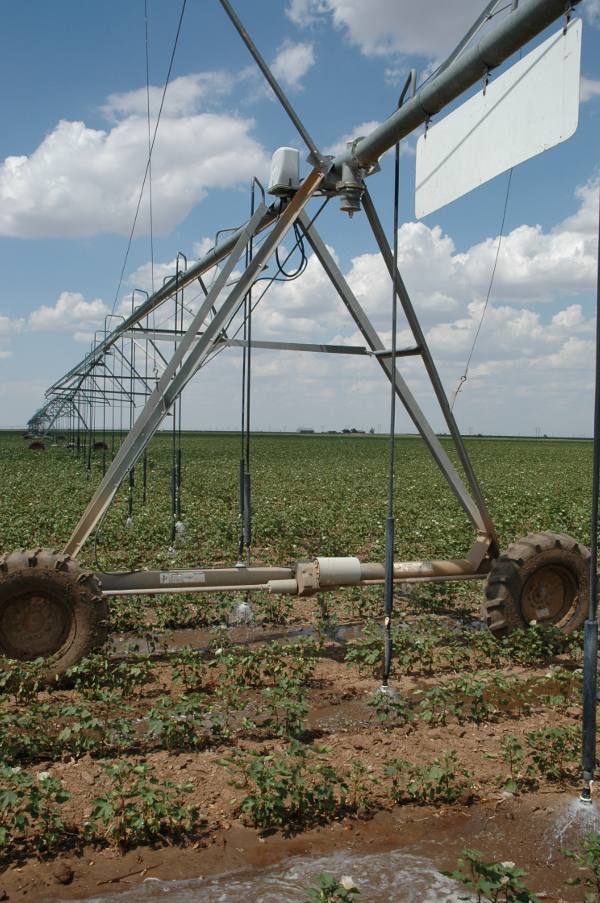
Irrigation rates and per day use of water from the Ogallala Aquifer have been sliced in half.Adoption of new irrigation technology, additional water stewardship highlights new Okla. Panhandle water strategy.Continued improvement in irrigation efficiency is a testimony to the stewardship ethic of the farm families of the Panhandle.
April 15, 2013

Irrigation rates and per day use of water from the Ogallala Aquifer have been sliced in half through the adoption of improved irrigation technology and improved water stewardship, according to the recently release Panhandle Regional Water Plan.
The study cites data from the United States Geological Survey (USGS) showing that while from 1995 to 2005 total acres of irrigated crop land increased, the total yearly use of water for irrigation was cut by more than half. According to Duane Smith, head of Duane Smith and Associates, the consulting firm that compiled the study, this reduction greatly lengthens the usable life of the Ogallala Aquifer.
“We know the Ogallala is a finite resource of water, but the numbers show that with continued adoption of new technology and better stewardship this water should be available for a long time,” Smith said. “The water users of the Panhandle have done a great job in improving the efficiency of their water usage and with continued improvement, we can continue to stretch each drop of water further and add more years of life to the aquifer.”
Smith cited numbers compiled by the USGS that show overall water use from the Ogallala peaked in the 1970s with a steady decline since. These same numbers show that from 1995 to 2005 total yearly use of water for irrigation declined from more than 600 million gallons per year to less than 220 million gallons per year. During the same period, the total number of irrigated crop acres in the Panhandle showed a slight increase from 230,918 acres to 232,058 acres, and overall market value of agriculture activity in the Panhandle showed an increase of more than 10 percent. According to Vicki Ayers-McCune, executive director of Panhandle Regional Economic Development Coalition (PREDCI), this data clearly shows economic activity and good water stewardship go hand in hand.
“The citizens of the Panhandle know the importance of protecting our water,” Ayers-McCune said. “We are dedicated to conserving this resource and using it wisely, not just for ourselves, but for future generations. These numbers show that our irrigators are working hard to protect this precious resource.”
If you are enjoying reading this article, please check out Southwest Farm Press Daily and receive the latest news right to your inbox.
Clay Pope, Executive Director of the Oklahoma Association of Conservation Districts (OACD), said this continued improvement in irrigation efficiency is a testimony to the stewardship ethic of the farm families of the Panhandle and points to the lessons learned by those who have living memory of the Dust Bowl. Pope also recognized the partnership of the USDA Natural Resource Conservation Service (NRCS), local conservation districts and local landowners, who through 2008 farm bill programs such as the Environmental Quality Incentives Program (EQIP), the Conservation Stewardship Program (CSP) and the Agriculture Water Enhancement Program (AWEP), were able to put over $6 million in financial assistance on the ground to implement conservation practices that will continue improving water utilization rates in the Panhandle through improved irrigation efficiency, conversion to no-till cropping and adaptation of conservation crop rotations.
“The folks who farm and ranch in far Northwest Oklahoma either lived through the Dust Bowl themselves or had grandparents and parents who lived through that horrible time,” Pope said. “It’s telling that during this time of record drought, the land in the Panhandle has actually been in better shape than a lot of the farm ground down state. That’s a real testimony to the lessons these folks learned the hard way about protecting our natural resources. This latest information concerning irrigation is just another example of how these producers, both on their own and with help from the conservation partnership, are working to better manage this precious resource and we are glad to be part of it.”
The Panhandle Regional Water Plan can be downloaded at: http://www.predci.com
You may also like:
Crop insurance and conservation compliance
Meeting water demand requires unusual solutions
Increasing number of irrigation wells threatens S. Plains aquifer
You May Also Like



